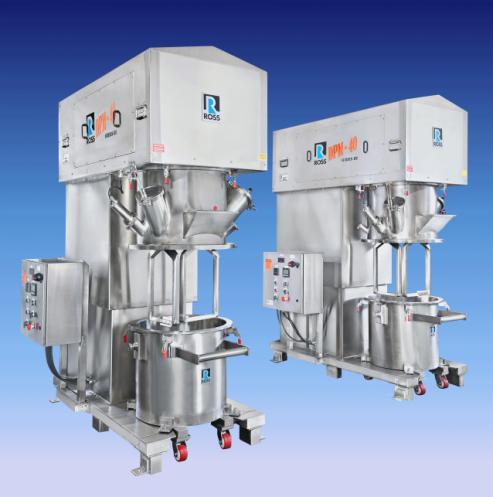Tech Report
Tips for selecting the best planetary mixer for your process

Technology Brief
This bulletin presents some general guidelines for selecting the most appropriate planetary mixer configuration for a particular application.
Planetary mixing
Double planetary mixers and planetary dispersers are commonly used for viscous and dense applications. The agitators rotate on their own axes while orbiting the vessel. This results in a very thorough mixing action regardless of product rheology. Batch components are constantly being recombined and moved from one area of the vessel to another until a homogenous state is achieved. Aside from their primary use in compounding high viscosity formulations, planetary mixers are also utilized as granulation and vacuum drying equipment.If you are in the market for a planetary mixer, here are some guidelines to help you select the best configuration for your process.
- What is the viscosity range of your application? Most batch mixing processes will usually undergo a number of viscosity changes. Consider the viscosity of your starting liquids, the maximum viscosity reached during mixing and the final viscosity after let-down or after all raw materials have been completely incorporated. Double planetary mixers are capable of handling a wider viscosity range than planetary dispersers. When equipped with helical stirrers, such as the Ross High Viscosity "HV" blades (US Patent No. 6,652,137), a double planetary mixer will mix materials up to around 6 million cP or more.
- Do you need high speed agitation? This issue is actually also related to viscosity. Double planetary mixers operate at relatively low speeds and rely on high product viscosity to impart shear and disintegrate any agglomerates in the batch. When working with materials in the range of 100,000 cP to around 2 million cP, the high speed mixing action of a planetary disperser is generally more effective in wetting out solids and creating a fine dispersion. Some very challenging applications benefit from two planetary stirrers and two disperser shafts. The combined mixing power of these agitators is ideal for rapid incorporation of large amounts of solids into a viscous vehicle. Mixer testing will confirm the most efficient method of processing and order of ingredient addition.
- Prevent "climbing" issues. Whether in a double planetary mixer or a planetary disperser, certain materials will tend to climb up the vertical flights of the rectangular stirrer(s) and out of the mix vessel. This characteristic migration of batch material reduces mixing efficiency, necessitates intensive clean-up and can even increase contamination risks. Consider using "HV" blades instead, if you experience this phenomenon with your material. Each helical leg of the HV blade follows a precisely angled contour - the sweeping curve firmly pushes the product forward and downward, keeping it within the mixing zone at all times.
- Optimize your discharge process. Discharging a viscous batch by gravity alone takes a long time and can require additional hours of manual scraping if the product is particularly heavy or sticky. To simplify discharge and clean-up, use an automated discharge system with your planetary mixer. In most set-ups, the mix vessel is simply wheeled to the discharge station and a platen is lowered into it. A specially-fitted O-ring on the platen rides against the vessel wall, literally wiping it clean. Finished product is forced out through a valve in the vessel or the platen.
Ross Planetary Mixers - Sample Configurations

Double Planetary Mixer with Rectangular Stirrers

Double Planetary Mixer with High Viscosity "HV" Blades

PowerMix Planetary Disperser with Rectangular Stirrer, Dual-Blade High Speed Disperser and Sidewall Scraper Arm

Planetary Dual Disperser with Two Rectangular Stirrers and Two Disperser Shafts
Can I safely process my sanitary application in a planetary mixer?

Well-designed double planetary mixers and planetary dispersers easily adapt to sanitary processing and contamination-free requirements. Options such as sealed and purged gearbox assemblies, all-stainless steel construction, gable-top bonnets, sanitary valves, charge ports and liquid spray nozzles are available.